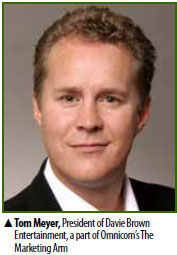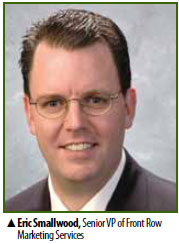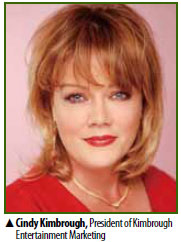Whereas previous generations purchased out of necessity, new breeds of consumers purchase out of desire and temptation. Cause and effect may be difficult to determine, and yet there is no doubt that “products” have invaded almost every facet of our lives. Print, television, multimedia, websites, mobile — advertisements are everywhere. As security marketing is also increasingly seen in Hollywood or Hollywood-ish productions, a&s takes a look at the phenomenon.
Whereas previous generations purchased out of necessity, new breeds of consumers purchase out of desire and temptation. Cause and effect may be difficult to determine, and yet there is no doubt that “products” have invaded almost every facet of our lives. Print, television, multimedia, websites, mobile — advertisements are everywhere. As security marketing is also increasingly seen in Hollywood or Hollywood-ish productions, a&s takes a look at the phenomenon.
Advertisements have become so ubiquitous and intrusive that many people eventually learn to filter out the message, both visual and aural. Marketing professionals, however, have adapted. Advertisements have since expanded into the program itself — in movies, TV shows, music videos, video games — rather than stay content with being fit between lines. Vendors sponsor these programs in exchange to have their products placed within the program, either for exposure or association with an atmosphere, emotion or person. Product placement guarantees that the product or brand is exposed to a large and diverse audience.
 In general, an advertiser wants to associate its brand or product with an entertainment property that its target market enjoys watching and is passionate about, said Tom Meyer, President of Davie Brown Entertainment, a part of Omnicom's The Marketing Arm. “They hope that the affinity that the viewer has for this movie or TV show transfers to their brand, making their brand feel more exciting or relevant to that viewer. Hopefully, a viewer will feel differently about the brand or product, and purchase it later based on their feelings about the brand.”
In general, an advertiser wants to associate its brand or product with an entertainment property that its target market enjoys watching and is passionate about, said Tom Meyer, President of Davie Brown Entertainment, a part of Omnicom's The Marketing Arm. “They hope that the affinity that the viewer has for this movie or TV show transfers to their brand, making their brand feel more exciting or relevant to that viewer. Hopefully, a viewer will feel differently about the brand or product, and purchase it later based on their feelings about the brand.”
Hitachi, the Japanese electronics company, said in a 2005 press release, “The global partnership with ‘War of the Worlds' marks a new period for Hitachi regarding how they approach entertainment and marketing. Adopting a new method combining product placement, whereby Hitachi contributes the company's products for use in films, and cross promotion, which supports and advertises the company or its products by utilizing product images in films, Hitachi is aiming to not simply carry out conventional advertising activities for product exposure, but to provide news hooks, deliver messages to stakeholders, and improve its company image.”
 Product placement is a great tie-in and affinity with a major motion picture or TV show, aligning products or services with a popular and well-accepted actor, said Eric Smallwood, Senior VP of Front Row Marketing Services. “Additionally, the viewership of films or shows is in the millions, which provides vendors with a great ROI for their advertising dollars. By integrating their brand into TV shows and movies, they not only ‘Tivo-proof' their products, but may also have the opportunity to demonstrate features of their product.”
Product placement is a great tie-in and affinity with a major motion picture or TV show, aligning products or services with a popular and well-accepted actor, said Eric Smallwood, Senior VP of Front Row Marketing Services. “Additionally, the viewership of films or shows is in the millions, which provides vendors with a great ROI for their advertising dollars. By integrating their brand into TV shows and movies, they not only ‘Tivo-proof' their products, but may also have the opportunity to demonstrate features of their product.” 
The brand may also wish to associate itself with the characters or actors in the content as an implied endorsement. They are then able to utilize public-relation (PR) stunts to bring attention to product use in consumers' favorite shows or with their favorite actors, said Cindy Kimbrough, President of Kimbrough Entertainment Marketing. “When we placed an Oncam Global camera in the final season of ‘24' at the new CTU, we were able to use shots of the CTU and the association with Jack Bauer in PR efforts to bring a sexiness to the product and reaffirm the high-tech nature of the camera.”
Placed Where?
Wth the guaranteed audience, the vendor is then able to enhance brand image by presenting the products in, preferably, a favorably designed spotlight.
Most scenes that feature product placement in films and TV reflect actual environments and are consistent with the storyline. “Video surveillance also appears in films and TV where it makes sense to the show and story. We have even done some placements for our client, Cisco Systems, where the video surveillance equipment/monitors are a part of the storyline,” Meyer said. “Generally speaking, it's not a coincidence that accounts for the appearance of a brand.
A vendor is chosen to appear depending on whether that system is specific to the storyline (geographic, for example, in a certain country), or if the vendors are using product placement agencies to call on the TV/film production to offer them free use of their products.”
Brands hire marketing agencies to seek out opportunities for product placements that are appropriate for the brand. “It's almost like playing the lottery: If you don't buy the ticket, you can't be winning. If you're not there, you can't be seen,” Kimbrough said. “In the case of 24's use of the OnCam Global camera, it was used because I was the only one representing a camera at the time.”
Most often, studios send scripts to these agencies to review and propose suitable products. The agencies also check in, from time to time, with their contacts to remind them which products they represent, so that prop masters and scene decorators will come to them when needs arise, Kimbrough said. “Such agencies create opportunities for vendors, allowing their brand or product to appear in front of the audience. This is especially needed for products like security cameras, where use is very limited.”
In most cases, vendors do not have the final say in where the product is placed, which makes it difficult to dive in and take the bite. Exact placement is difficult to control, and there are many cases where something went wrong, Kimbrough said. “However, for the most part, it works. Otherwise, brands would not be doing it; and major, major brands do it.”